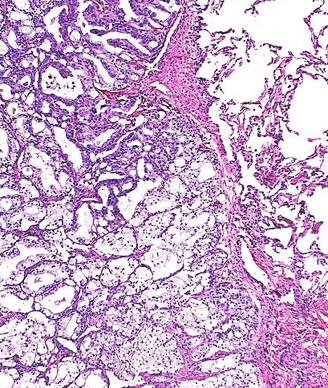Survival Outcomes Do Not Improve With Pembrolizumab/Enzalutamide in mCRPC
Subgroup analyses in the phase 3 KEYNOTE-641 trial do not indicate an overall survival improvement with pembrolizumab plus enzalutamide in metastatic castration-resistant prostate cancer.
“Future studies should focus on patient selection and the identification of positive predictive markers of response, more so than treating all comers, which several studies have shown has not really worked here or they acknowledge it,” according to Julie N. Graff, MD.

Investigators observed no improvements in overall survival (OS) or radiographic progression-free survival (rPFS) with pembrolizumab (Keytruda) plus enzalutamide (Xtandi) compared with enzalutamide on its own among patients with metastatic castration-resistant prostate cancer (mCRPC), according to findings from the phase 3 KEYNOTE-641 trial presented at the 2023 European Society for Medical Oncology Congress (ESMO).
As a result, the primary end points–OS and rPFS per PCWG-modified RECIST 1.1 by blind independent central review–were not met and the study was stopped for OS futility at the first interim analysis.
“Future studies should focus on patient selection and the identification of positive predictive markers of response, more so than treating all comers, which several studies have shown has not really worked here or they acknowledge it,” Julie N. Graff, MD, Oregon Health & Science University Knight Cancer Institute, said during a presentation of the data.
The median follow-up time at first prespecified interim analysis was 27.6 months (range, 6.1–39.8). At that time, median OS was 24.7 months (95% CI, 22.0-26.8) with placebo plus enzalutamide, compared with 27.3 months (95% CI, 24.5-30.1) with placebo plus enzalutamide (HR, 1.04; 95% CI, 0.88-1.22; P = .66)
Further the 12-month OS rates in the pembrolizumab and placebo arms were 77.9% vs 77.6%, respectively, whereas 18-month rates were 63.6% vs 63.0%.
Subgroup analyses—stratified by age, race, region, ECOG performance status, prior docetaxel for metastatic hormone-sensitive prostate cancer, prior abiraterone therapy, metastases at baseline, and PD-L1 status—also did not demonstrate an OS benefit with pembrolizumab and enzalutamide over placebo and enzalutamide.
Median rPFS with pembrolizumab plus enzalutamide was 10.4 months (95% CI, 8.4-12.5), vs 9.0 months (95% CI, 8.3-11.5) with placebo (HR, 0.98; 95% CI, 0.84-1.14; P = .41).
Similar to OS, there was no rPFS benefit seen across the prespecified subgroup analysis.
The investigators evaluated time to initiation of first subsequent anticancer therapy (TFST) as a secondary end point of the study. Median TFST with pembrolizumab vs placebo was 13.2 months (95% CI, 11.7-15.7) and 12.6 months (95% CI, 11.3-14.2), respectively (HR, 0.95; 95% CI, 0.83-1.09).
Additionally, objective response rate (ORR) served as a secondary end point. The ORR with pembrolizumab plus enzalutamide was 32.3% (95% CI, 26.2%-38.6%), including 17 complete responses (CRs; 7.4%), of which 5 of those patients received prior abiraterone (2.2%); compared with an ORR of 23.9% (95% CI, 18.5%-30.0%) with placebo plus enzalutamide, including 6 CRs (2.7%), of which 2 of those patients received prior abiraterone (0.9%). The disease control rate in each respective arm was 50.0% (95% CI, 43.4%-56.6%) and 46.0% (95% CI, 39.4%-52.8%).
“Interestingly, complete response was higher with pembrolizumab plus enzalutamide. However, it's not clear what the molecular changes were to the tumor that might have allowed this,” Graff said.
Across the pembrolizumab and placebo arms, grade 3 or higher adverse events (AEs) occurred in 55.8% and 41.0% of patients, respectively, whereas grade 3 or higher treatment-related AEs were seen in 31.2% and 10.8% of patients, and 30.9% and 7.4% of patients had immune-mediated AEs and infusion reactions.
The most common AEs occurring in at least 5% of patients in the pembrolizumab and placebo arms included fatigue (22.9% vs 19.8%, respectively), rash (18.7% vs 4.0%), pruritus (11.9% vs 4.5%), nausea (11.1% vs 8.5%), decreased appetite (10.9% vs 9.0%), diarrhea (10.7% vs 7.1%), asthenia (9.9% vs 2.9%), hypothyroidism (9.9% vs 2.9%), maculopapular rash (6.8% vs 0.6%), arthralgia (6.5% vs 4.2%), anemia (5.4% vs 3.7%), and hypertension (4.4% vs 5.2%).
In the randomized, double-blind phase 3 KEYNOTE-641 study, investigators randomized patients 1:1 to receive either 200 mg pembrolizumab IV every 3 weeks (n = 621) or placebo every 3 weeks (n = 623) plus 160 mg oral enzalutamide every day.
To be eligible for the trial, patients had to have confirmed m CRPC; no prior docetaxel for the disease; had no previously received prior enzalutamide, apalutamide (Erleada), or darolutamide (Nubeqa); had an ECOG performance status of 0 or 1; and had a tissue sample available for biomarker assessment. Prior treatment with abiraterone (Zytiga) was permitted.
At baseline, patients in the pembrolizumab arm were a median age of 71 years (median, 45-91). The majority had an ECOG performance status of 0 (58.3%). In total, 85.7% of patients had bone metastases, 12.2% has visceral metastases, and 3.5% had liver metastases. Regarding prior treatment received, 60.5% were given abiraterone and 29.0% were administered docetaxel. Lastly, most patients were PD-L1 negative (70.4%).
Data cutoff was December 12, 2022.
Reference
Graff JN, Burotto M, Fong PC, et al. Pembrolizumab (pembro) plus enzalutamide (enza) for patients (pts) with metastatic castration-resistant prostate cancer (mCRPC): Randomized double-blind phase III KEYNOTE-641 study. Ann Oncol. 2023;34(S2):S957. doi:10.1016/j.annonc.2023.09.2721.
Newsletter
Stay up to date on recent advances in the multidisciplinary approach to cancer.
Navigating Treatment Intensification in Metastatic Hormone-Sensitive Prostate Cancer
A patient case of a 50-year-old man with hormone-sensitive prostate cancer sparked a debate among oncologists regarding the best course of action.